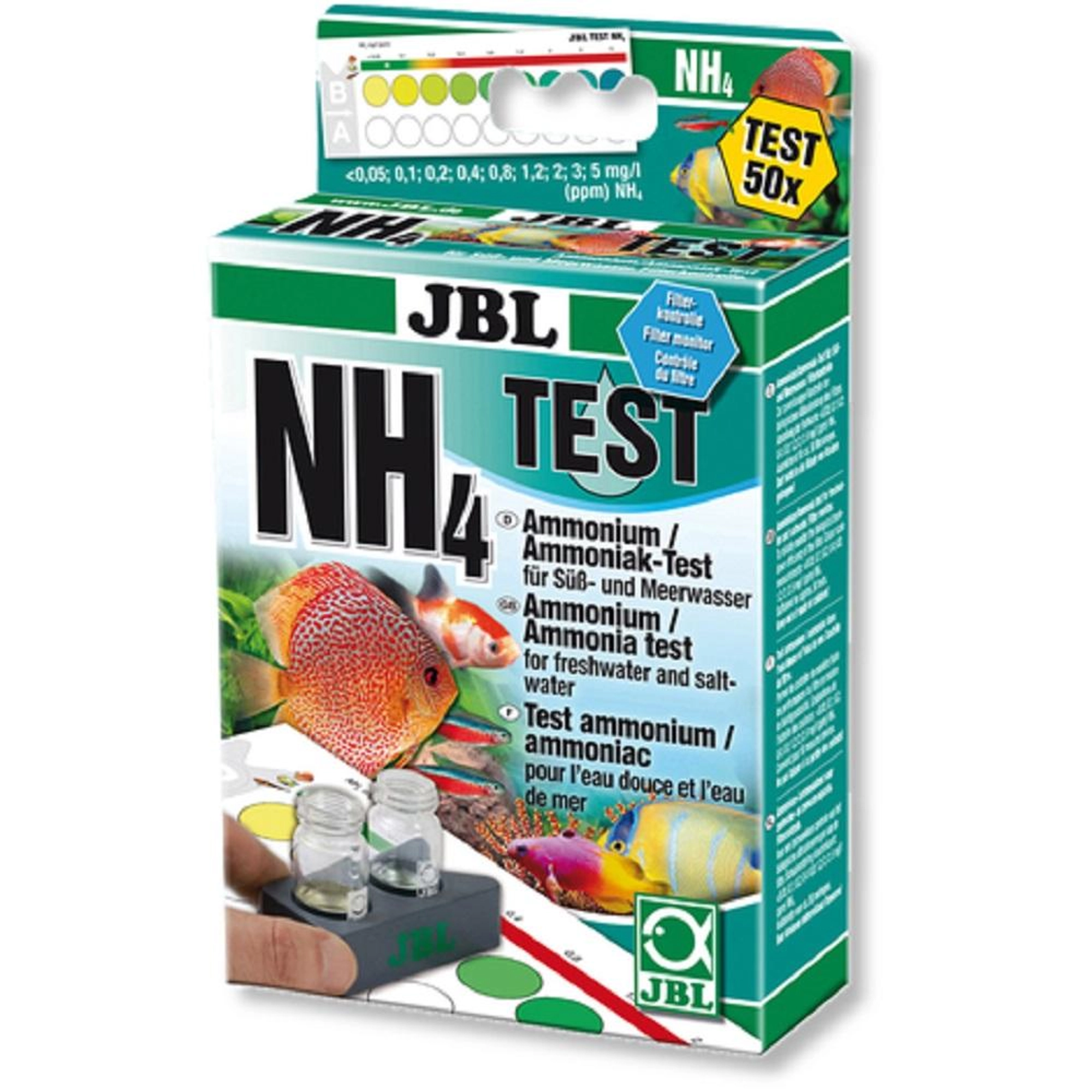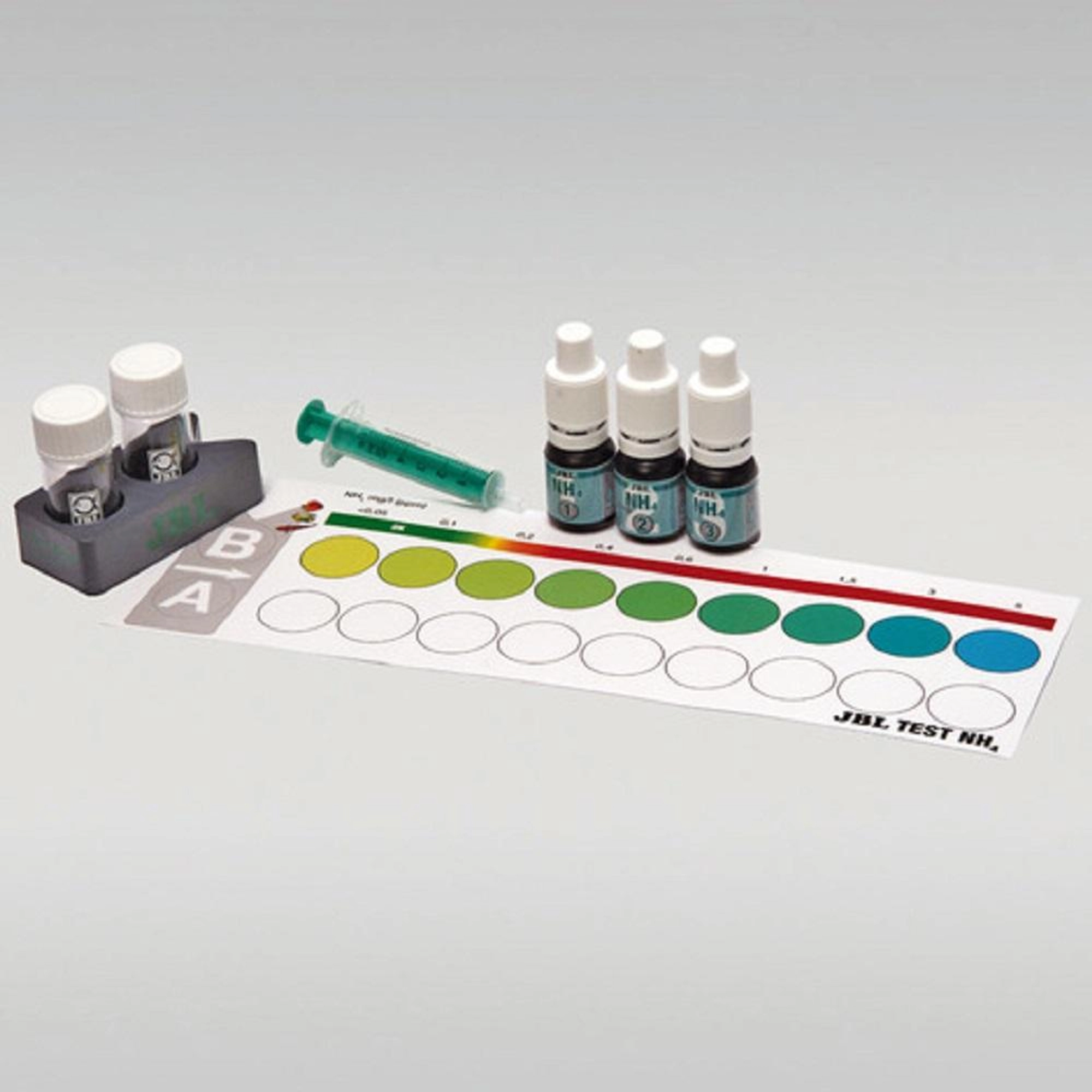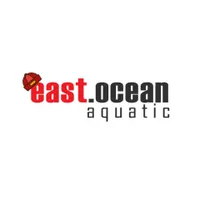



Product Details
- Simple and reliable monitoring of the aquarium/pond water values.
- Checks the biological balance (bacterial activity) in freshwater and marine water.
- Laboratory comparator system to compensate any inherent water colouring: fill glass vials with sample water, add reagents to another vial, place vials in holder, read values on colour chart.
- When to use: for setting up a new freshwater aquarium: once a day. Initial setup with marine water: once a week. For use in case of fish diseases or fish deaths.
- Online Laboratory: free analysis and recommendations for the water values you have measured.
- Package contents: 1 quick test, Ammonium Test NH4. Contents for approx. 50 measurements. Incl. 3 reagents, 2 glass vials with screw cap, syringe, comparator block and colour scale. Refill reagents available separately.
PRODUCT INFORMATION
Healthy aquarium/healthy pond with conditions close to nature:
- The right water values are dependent on the fish stock and the plants in the aquarium/pond.
- Even if the water looks clear it can be contaminated.
- With bad values diseases or algae can appear in the aquarium/pond.
- To maintain a healthy aquarium/pond with conditions close to nature it is important to check and adapt the water values regularly.
- For each water analysis JBL provides water tests in the form of quick tests or colour change tests.
- These determine a certain value or several values in one go.
- With these water tests you can recognise algae problems and negative nitrate, nitrite, potassium, magnesium values etc.
Why test?
- The degradation or mineralisation process of all organic substances in the aquarium and pond follows these stages: proteins > ammonium > nitrite > nitrate.
- By measuring these stages conclusions can be drawn about the “functioning” of the systems aquarium and pond. If the ammonium or nitrite level is too high it can lead to disturbances of the bacterial balance.
- Ammonium is not usually measurable in a maintained aquarium with an effective biological filter and in a correctly set up garden pond.
- Ammonium is an important plant nutrient and normally non-toxic for fish. But depending on the pH value ammonia, which is toxic for fish, can be formed from the ammonium ion.
Recommended ammonium values:
- Freshwater aquarium (community aquarium): < 0.25 mg/l
- Lake Malawi/Lake Tanganyika aquarium: < 0.25 mg/l
- Plant aquarium with few fish (aquascaping): < 0.25 mg/l
- Marine aquarium: 0-0.25 mg/l
- Pond: <0.1 mg/l.
You can analyse the water values you have measured in the JBL Online Laboratory free of charge and receive recommendations.
FAQ
Where can I find the record sheets for the documentation of my water analysis?
> Have you lost your record sheets, already filled them all in or do you need them in another language?
With the following links you can quickly and easily print out your new record sheets with recommendations for the individual parameters at home and document the water analyses.
English: https://www.jbl.de/?lang=en&mod=files&func=show&id=11164
I have lost my colour chart. Can I download the colour chart for the test?
> The colour cards are not available for download on the JBL website. The absolutely accurate colour reproduction that is required can only be achieved using a printer which can be re-calibrated before each printout. Most privately used printers are not accurate enough for this.
You will find the colour chart bundle as a spare part on the respective product page and in the spare parts shop under: https://www.jbl.de/en/products/detail/8732/jbl-proaquatest-assortiment-color-chart.
What can I do when the measured value of a water test falls outside the scale?
> If one of your measurements reaches the end of the colour chart scale you can multiply the scale by diluting later tests with distilled water (e.g. JBL Dest).
Here’s how to do it: dilute the sample with distilled water and carry out the test once more.
This works in detail as follows:
GH test: Instead of 5 ml use 10 ml aquarium water. Now 1 drop is equivalent to 0.5 dGH.
KH test: Instead of 5 ml use 10 ml aquarium water. Now 1 drop is equivalent to 0.5 dGH.
Note: when using 10 ml sample water the colour development is weaker with the first drops than with 5 ml sample water. Put the measuring container on a white underlay for a better readability.
NH4/NH3 ammonium/ammonia, NO2 nitrite, Fe iron and Cu copper:
2.5 ml sample + 2.5 ml dist. water: result times 2
1 ml sample + 4 ml dist. water: result times 5
0.5 ml sample + 4.5 ml dist. water: result times 10
NO3 nitrate, SiO2 silicate, PO4 phosphate sensitive and Mg magnesium freshwater:
5 ml sample + 5 ml dist. water: result x 2
2 ml sample + 8 ml dist. water: result x 5
1 ml sample + 9 ml dist. water: result x 10
PO4 phosphate koi high range:
2.5 ml sample + 2.5 ml dist. water: result x 2
1 ml sample + 4 ml dist. water: result x 5
K potassium:
7.5 ml sample + 7.5 ml dist. water: result x 2
3 ml sample + 12 ml dist. water: result x 5
1.5 ml sample + 13.5 ml dist. water: result x 10
K potassium in marine water:
1. Fill 10 ml of sample water with distilled water to 300 ml.
2. Follow the instructions for fresh water.
3. Multiply the test result by a factor of 30.
CO2 direct, Ca calcium and Mg+Ca magnesium+calcium: not required.
Which of the three scales on the colour cards symbolize of the water tests saltwater, freshwater and garden pond ?
>koi carp = garden pond
angel fish = saltwater
discus = freshwater
Which scale applies for my aquarium? My test has two or three control fields with fish and recommendations.
> We repeatedly receive questions regarding the symbols on the water test. The hobby areas cannot be clearly assigned to the scales for analysis. There are three symbols to make the hobby areas on the colour charts clear:
Discus = fresh water
Emperor = salt water
Koi = garden pond
In the following, you will find a list which assigns the scale for analysing the results from measurements in the hobby area and explains the symbols: The scales are described from the top to the bottom here.
NO3: salt water, fresh water, garden pond
pH 6.0 – 7.6: fresh water, garden ponds
pH 7.4 – 9.0: salt water, fresh water, garden pond
Fe: fresh water, garden pond
The following JBL tests have a uniform scale for all 2 or 3 hobby areas for analysis of the results from the measurements, as differentiation is no longer necessary:
SiO2
Cu
NH4
NO2
PO4
pH 3-10
O2
JBL NH4 Ammonia Test Set
Product Options
Regular
Delivery
 East Ocean Aquatic Havelock
East Ocean Aquatic Havelock Aquarium Fishes, Tanks & Supplies From East Ocean Aquatic Havelock


 SG
SG


